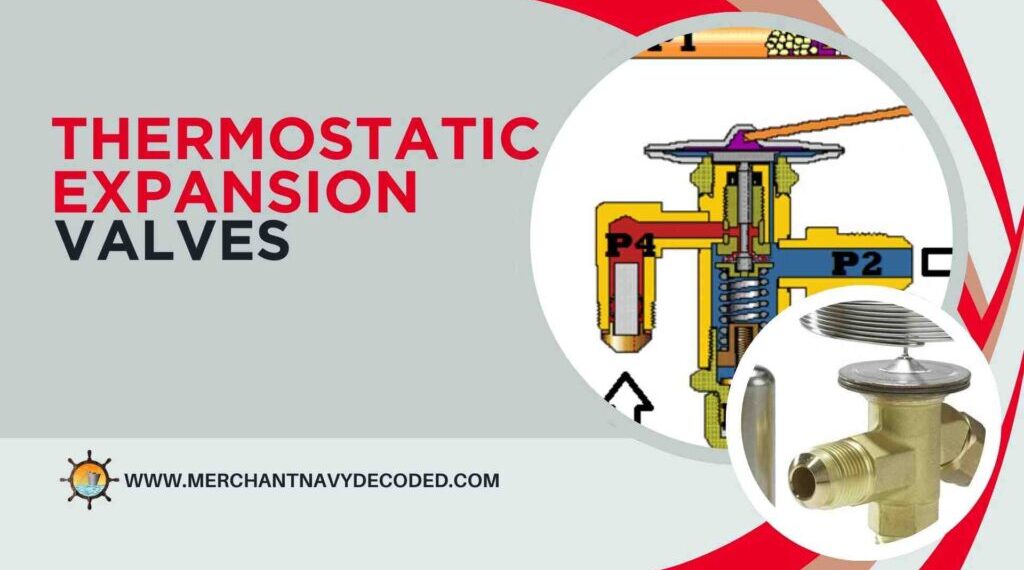What is Thermostatic Expansion Valve on a Refrigeration System
1:- What is Thermostatic Expansion Valve
A Thermal or Thermostatic Expansion Valve is used in refrigeration and air conditioning systems. It functions as a throttling mechanism, controlling the flow of refrigerant into the system’s evaporator depending on the temperature and pressure conditions at the evaporator output.
The expanse valve of a thermostatic nature is the one that controls and maintains the flow of refrigerant in the evaporator coil. It is in the evaporator coil that heat gets absorbed by refrigerant and evaporates hence cooling air/space in a system, finally. Adjusting the amount of refrigerant flowing through it helps to keep the constant working condition of a refrigerating or air conditioning unit. This keeps excessive heating and flooding out, in this case referred to as overcharge.
2:- What are the Parts of Thermostatic Expansion Valve?
A thermostatic expansion valve typically consists of many critical components that work together to control the flow of refrigerant into the evaporator coil in refrigeration and air conditioning systems. Here are the primary components of a TXV:
- Diaphragm: This is a flexible membrane that moves in response to pressure differentials. It is connected to the valve stem and adjusts the valve opening based on the pressure conditions.
- Power Element: The power element includes the diaphragm, sensing bulb, and capillary tube. It senses the temperature at the outlet of the evaporator coil (superheat) and adjusts the valve opening accordingly.
- Sensing Bulb: The sensing bulb is filled with a temperature-sensitive fluid (often a refrigerant or a mixture) and is mounted at the outlet of the evaporator coil. It detects changes in evaporator temperature, which affects the pressure inside the bulb and thus the position of the diaphragm.
- Setting Spring: This spring exerts a force opposing the diaphragm’s movement. It is adjustable to set the baseline pressure at which the valve begins to open.
- Orifice: The orifice controls the flow of refrigerant into the evaporator coil. It is typically a small opening that regulates the rate at which refrigerant enters based on the position of the diaphragm.
It is the combination of these components that makes certain superheat levels in the evaporator coil well maintained by a thermostatic expansion valve. The TXV optimizes system efficiency and performance in refrigeration and air conditioning applications by manipulating refrigerant flow in response to superheat variations and system load changes.
Want to learn more about Refrigeration Systems and thermostatic expansion valves, check out our Combo Package which will clear all your doubts and concepts regarding IC Engines and boilers, and has live engine room rounds for a better understanding of engine room machinery.
3:- How Does a Thermostatic Expansion Valve Work
Step 1: Pressure Reduction and Vaporization: High-pressure liquid refrigerant enters the TXV and passes through the orifice, causing a rapid pressure drop. This pressure drop allows some of the refrigerant to vaporize while the rest remains in liquid form.
Step 2: Evaporator Absorption: The mixed-phase refrigerant (liquid and vapor) enters the evaporator coil where it absorbs heat from the surrounding environment (air or water). The fan blows air across the coil to facilitate heat transfer.
Step 3: Superheat Adjustment: As the refrigerant absorbs heat, it undergoes a phase change from liquid to vapor. Towards the end of the evaporator coil, it becomes a saturated vapor. The TXV ensures that a controlled amount of refrigerant evaporates to maintain a precise superheat level.
Step 4: Sensing and Adjustment: The sensing bulb continuously measures the temperature at the outlet of the evaporator. When cooling loads increase (more heat to absorb), more refrigerant is vaporized thereby increasing superheat. The sensing bulb senses this temperature rise, causing boiling of refrigerant within it leading to an increase in pressure. This pressure change alters the position of a diaphragm, thus allowing extra flow of refrigerant for maintaining correct superheating.
Step 5: System Stability: Conversely, if the cooling load decreases, the Thermostatic expansion valve reduces the refrigerant flow to prevent excessive cooling and maintain system efficiency.
4:- Types of Thermal Expansion Valves
Thermal expansion valves (TXVs) come in different types, each suited for specific applications and refrigerants. Here are the main types:
4.1:- Thermostatic Expansion Valve (TEV or TXV):
Differences between Externally vs. Internally Equalized Thermostatic Expansion Valves
| Aspect | Externally Equalized TXV | Internally Equalized TXV |
| Pressure Equalization | Uses an external line to equalize pressure at the outlet of the evaporator with the pressure at the sensing bulb. | Uses an internal passage to equalize pressures within the valve. |
| Control Precision | Provides accurate control over a wide range of operating conditions. | Offers slightly less precise control compared to externally equalized valves. |
| Installation Complexity | Requires additional installation steps due to the external equalizer line. | Simplifies installation by eliminating the need for an external equalizer line. |
| Application Suitability | Ideal for systems with varying pressure drops across the evaporator. | Suitable for systems with relatively stable pressure conditions. |
| System Performance | Enhances system performance by maintaining optimal superheat levels. | May result in less optimal superheat control under varying load conditions. |
| Common Use Cases | Often used in larger, more complex refrigeration and air conditioning systems. | Commonly used in smaller or simpler systems where installation simplicity is a priority. |
4.2:- Electronic Expansion Valve (EEV):
- Motorized Valve: Instead of using mechanical diaphragms and spring systems, such valves use motors that regulate opening depending on electronic signals. These offer accurate regulation of refrigerant flows and are commonly utilized in more advanced HVAC systems.
5:- Conclusion
In conclusion, the thermal expansion valve (TXV) is an important component in refrigeration and air conditioning systems, since it regulates the flow of refrigerant into the evaporator to ensure maximum cooling efficiency. TXVs ensure stable operation by carefully controlling refrigerant flow depending on temperature and pressure conditions at the evaporator outlet, preventing concerns such as excessive superheat and flooding of refrigerants.
Disclaimer :- The opinions expressed in this article belong solely to the author and may not necessarily reflect those of Merchant Navy Decoded. We cannot guarantee the accuracy of the information provided and disclaim any responsibility for it. Data and visuals used are sourced from publicly available information and may not be authenticated by any regulatory body. Reviews and comments appearing on our blogs represent the opinions of individuals and do not necessarily reflect the views of Merchant Navy Decoded. We are not responsible for any loss or damage resulting from reliance on these reviews or comments.
Reproduction, copying, sharing, or use of the article or images in any form is strictly prohibited without prior permission from both the author and Merchant Navy Decoded.



